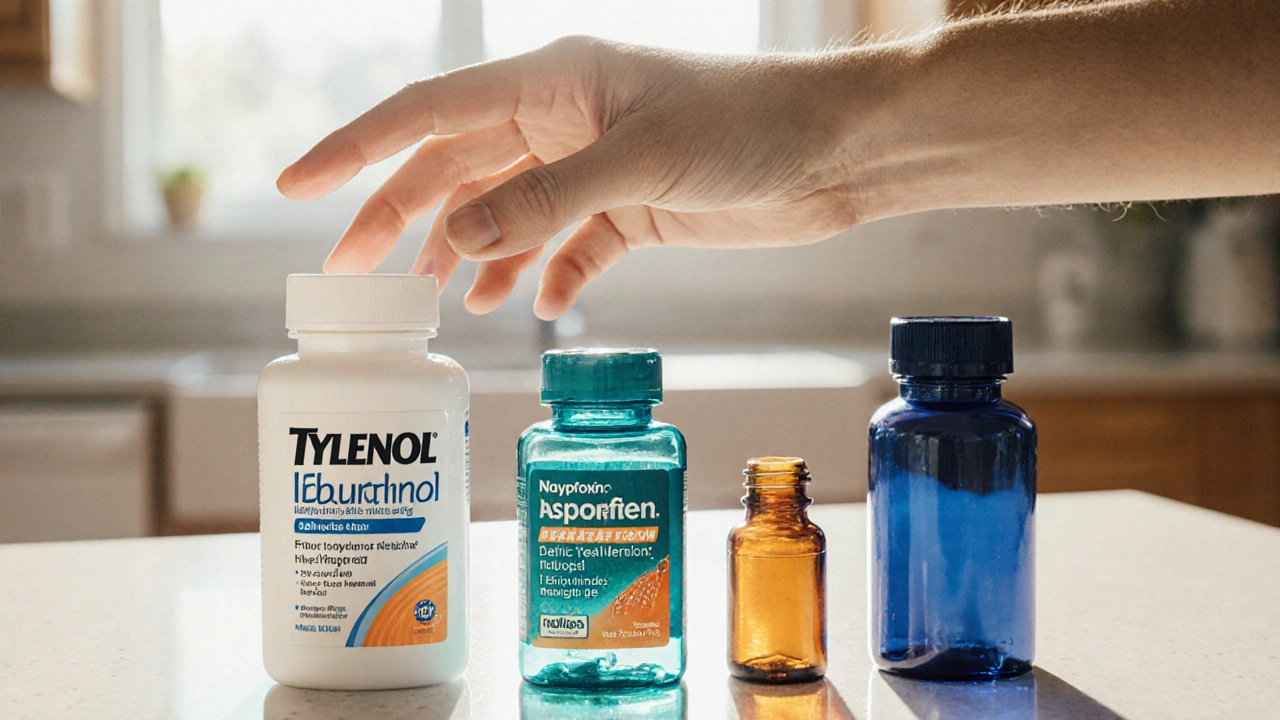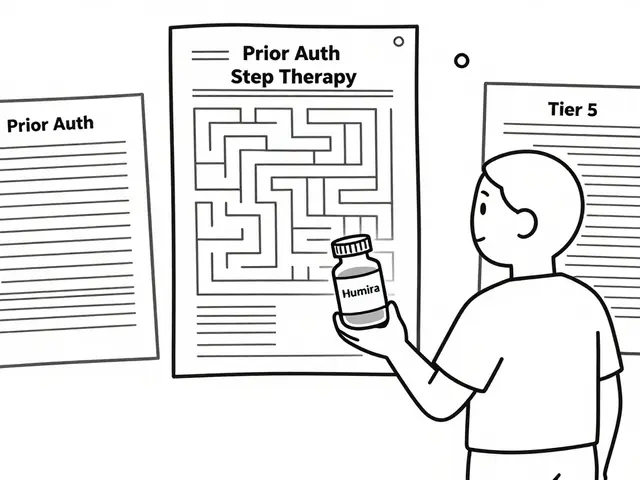Pain Reliever Selector
Select Your Symptoms
Tylenol is a brand name for acetaminophen, a widely used pain reliever and fever reducer. It works by blocking the brain’s pain signals without reducing inflammation. People reach for Tylenol when they need quick relief from headaches, mild arthritis, or a fever, especially if they can’t tolerate stomach‑irritating drugs.
Quick Take
- Tylenol is safest for kids and people with stomach issues.
- Ibuprofen and naproxen are better for inflammation.
- Aspirin adds blood‑thinning benefits but raises bleed risk.
- Combination products (acetaminophen+caffeine, codeine, or diphenhydramine) target specific symptoms.
- Choose based on pain type, age, health conditions, and dosing convenience.
Why People Compare Pain Relievers
When a headache hits or a muscle aches after a jog, the first question is usually, “What should I take?” The market offers a handful of over‑the‑counter (OTC) options, each with its own strengths and downsides. Comparing them helps you avoid duplicate ingredients, prevent side‑effects, and get the fastest, most comfortable relief.
Key Comparison Criteria
Below are the factors most shoppers consider. Keep the list handy while you read the table later:
- Mechanism of action - how the drug eases pain.
- Typical adult dose - standard OTC amount.
- Onset - how quickly you feel relief.
- Duration - how long the effect lasts.
- Inflammation control - does it target swelling?
- GI (stomach) risk - likelihood of upset stomach or ulcers.
- Cardiovascular risk - impact on heart health.
- Kids safety - approved age ranges.
- Interaction cautions - common drug combos to avoid.
Side‑by‑Side Table
| Attribute | Tylenol (Acetaminophen) | Ibuprofen (Advil, Motrin) | Aspirin | Naproxen (Aleve) |
|---|---|---|---|---|
| Mechanism | Central pain signal blocker | Non‑steroidal anti‑inflammatory (NSAID) | NSAID with platelet‑inhibiting effect | Long‑acting NSAID |
| Typical adult dose | 500‑1000mg every 4‑6h (max 4000mg/24h) | 200‑400mg every 6‑8h (max 1200mg/24h OTC) | 81‑325mg every 4‑6h (max 4000mg/24h) | 220mg every 8‑12h (max 660mg/24h OTC) |
| Onset | 30‑45min | 15‑30min | 30‑60min | 45‑60min |
| Duration | 4‑6h | 4‑6h | 4‑6h | 8‑12h |
| Inflammation control | None | Good | Moderate | Strong |
| GI risk | Low | Moderate (may cause upset stomach) | High (ulcers, bleeding) | Moderate‑High (long‑acting GI exposure) |
| Cardiovascular risk | Neutral | Low‑moderate (caution with heart disease) | Increases bleed risk, can protect heart at low dose | Higher (risk of heart attack with chronic use) |
| Kids safety | Approved ≥2yrs (dose‑adjusted) | Approved ≥12yrs | Rarely recommended for kids (Reye’s syndrome) | Approved ≥12yrs |
| Key interaction cautions | Avoid with heavy alcohol, warfarin | Avoid with kidney disease, blood thinners | Avoid with anticoagulants, asthma | Avoid with heart disease, stomach ulcers |
When Tylenol Is the Right Choice
If you need relief without hurting your stomach, Tylenol often wins. It’s gentler on the gut, making it a go‑to for people on proton‑pump inhibitors or those who have a history of ulcers. Parents also appreciate the lower‑dose formulations for children as young as two.
However, Tylenol doesn’t reduce swelling. For a sore elbow from tennis or a menstrual cramp, an NSAID like ibuprofen will usually feel better because it tackles the inflammatory component head‑on.

When NSAIDs Take the Lead
Ibuprofen is an NSAID that eases pain, fever, and inflammation. Its quick onset (often under 20minutes) makes it popular for migraine attacks or dental work pain.
People with heart‑burn issues should watch ibuprofen doses, as the drug can irritate the lining of the stomach. Taking it with food or a glass of milk usually mitigates mild discomfort.
Naproxen offers a longer window of relief-up to 12hours-so you might need fewer pills on a busy day. That convenience comes with a higher GI load, so a lower‑dose prescription may be safer for chronic users.
Aspirin: The Odd One Out
Aspirin is both an analgesic and an antiplatelet agent. Low‑dose aspirin (81mg) is a mainstay for preventing heart attacks, but the regular 325mg dose can cause stomach bleeding, especially without food.
Because of the rare risk of Reye’s syndrome, doctors avoid aspirin for children with viral illnesses. If you’re looking for a blood‑thinner, ask your physician before self‑prescribing.
Combination Products: Targeted Relief
Some shoppers reach for combo pills like Tylenol+Caffeine, Tylenol+Codeine, or Tylenol+Diphenhydramine (the “PM” version). Caffeine widens blood vessels, helping severe headaches clear up faster. Codeine adds a true opioid kick, useful for post‑surgical pain but comes with dependence warnings.
Diphenhydramine makes the product drowsy, so it’s best saved for nighttime aches. These combos let you hit two birds with one pill, but they also raise the chance of side‑effects, so read the label carefully.
How to Choose the Best Option for You
Use this quick decision guide. Pick the bullet that matches your situation, then glance at the table for dose details.
- If you have a stomach ulcer, GERD, or are on blood‑thinners, reach for Tylenol.
- If your pain includes noticeable inflammation (sprain, arthritis flare), choose ibuprofen or naproxen.
- If you need cardiovascular protection and can tolerate the GI load, low‑dose aspirin may be appropriate-talk to a doctor first.
- For a headache that’s not responding to plain Tylenol, try a caffeine‑boosted combo.
- When you’re dealing with post‑operative or severe dental pain, a short course of codeine‑combined acetaminophen can be effective under medical supervision.
Common Pitfalls and How to Avoid Them
- Doubling up: Many cold medicines already contain acetaminophen. Adding a Tylenol tablet can push you past the 4g daily limit, risking liver damage.
- Alcohol mix: Combining alcohol with acetaminophen spikes liver stress. Keep drinks low‑key while you’re on any pain reliever.
- Ignoring weight‑based dosing for kids: A child’s dose is based on milligrams per kilogram. The “one‑size‑fits‑all” adult label can be dangerous.
- Long‑term NSAID use: Taking ibuprofen daily for months raises heart‑attack and kidney‑failure risk. Switch to intermittent Tylenol breaks when possible.
Bottom Line
Tylenol shines when you need a gentle, non‑inflammatory option-especially for children, sensitive stomachs, or when you’re already on blood thinners. NSAIDs like ibuprofen and naproxen dominate when swelling is part of the problem, but they require food and caution with heart or kidney issues. Aspirin adds a unique blood‑thinning benefit but isn’t a first‑line pain killer for most people.
By matching the drug’s strengths to your specific symptom and health profile, you’ll get faster relief with fewer side‑effects. Keep the comparison table handy, double‑check active ingredients, and you’ll navigate the OTC aisle with confidence.

Frequently Asked Questions
Can I take Tylenol and ibuprofen together?
Yes, alternating Tylenol and ibuprofen every three hours can provide stronger pain control while keeping each dose within safe limits. Always stay under the maximum daily amount for each drug.
Is Tylenol safe for people with liver disease?
People with chronic liver disease should limit acetaminophen to no more than 2g per day and only under a physician’s guidance. The liver processes acetaminophen, so excess can worsen existing damage.
Why does ibuprofen cause stomach upset?
Ibuprofen blocks prostaglandins that also protect the stomach lining. Without that protection, stomach acid can irritate the mucosa, leading to discomfort or ulcers.
Can I give my teenager aspirin for a headache?
Aspirin is generally not recommended for teens unless a doctor prescribes it for a specific condition, due to the risk of Reye’s syndrome and bleeding. Safer alternatives are Tylenol or ibuprofen.
What’s the advantage of naproxen’s longer duration?
You take fewer doses per day, which is handy for chronic pain like arthritis. The trade‑off is a higher chance of stomach irritation, so many users pair naproxen with food or a low‑dose proton‑pump inhibitor.






Ernie Rogers
Tylenol is fine for a quick fix
Eunice Suess
Wow, this guide is a real rollercoaster of info! You’ve got the facts straight but the drama in the way you peppered caffeine combos – I can totally feel the hype. Still, the typo‑free tables are a lifesaver, even if you occasionally drop an ‘i’ on “ibuprofen”.
Anoop Choradia
Esteemed readers, the discourse surrounding acetaminophen warrants a scrupulous examination that transcends the superficial comparisons offered herein. One must first acknowledge the entrenched pharmaceutical conglomerates that subtly manipulate public perception through orchestrated marketing campaigns. The omnipresent presence of acetaminophen in household cabinets is not a mere accident, but a calculated stratagem engineered to monopolize analgesic consumption. Moreover, the biochemical pathway by which acetaminophen exerts its central analgesic effect remains partially obfuscated, inviting speculation about undisclosed neurochemical interactions. It is incumbent upon the discerning individual to question why the mechanistic details are relegated to obscurity while rival NSAIDs receive exhaustive elucidation. Historical archives reveal that the elevation of acetaminophen to over‑the‑counter status coincided with strategic lobbying efforts aimed at marginalizing alternative therapies. Such temporal correlation cannot be dismissed as coincidental. Furthermore, the hepatic metabolism of acetaminophen, mediated chiefly by CYP2E1, predisposes certain populations to hepatotoxicity, a fact that is conspicuously downplayed in popular literature. The omission of comprehensive risk stratification reflects an ethical lapse in public health communication. One must also consider the geopolitical ramifications of drug export policies that prioritize acetaminophen availability in regions with limited medical infrastructure. The resultant dependency perpetuates a cycle of analgesic reliance that obscures the pursuit of holistic pain management. In light of these considerations, the recommendation to default to acetaminophen in the presence of gastrointestinal comorbidities, as suggested by the article, appears overly simplistic. A nuanced approach, integrating patient‑specific pharmacogenomic data, would constitute a more responsible paradigm. Finally, the interplay between acetaminophen and concomitant alcohol consumption invokes a synergistic hepatotoxic potential that demands vigilant counseling. To conclude, it is imperative that future discourse adopt a rigorously evidence‑based framework, eschewing complacent endorsement of any singular analgesic without exhaustive contextualization.
bhavani pitta
While the treatise commendably exposes systematic influences, it nevertheless overlooks the pragmatic benefits of acetaminophen for mild discomfort. A balanced perspective would acknowledge both the geopolitical concerns and the genuine therapeutic value.
Brenda Taylor
Thanks for the thorough rundown :)
Dawson Turcott
Yeah, love how they sprinkle a bit of codeine talk in the middle like it’s a secret sauce 😂
Alex Jhonson
Great summary! If you’re mixing meds, always double‑check the active ingredients to avoid accidental overdoses.
Katheryn Cochrane
This post nails the key points, but the author could have highlighted the liver toxicity risk more prominently. The table is solid, though the formatting could use a wider column for dosage limits.
Michael Coakley
Philosophically, pain is just the universe reminding us we’re alive, yet we still reach for a pill like it’s a magic wand.
ADETUNJI ADEPOJU
From a compliance standpoint, the risk‑benefit calculus of acetaminophen versus NSAIDs demands a granular stratification of patient phenotypes, especially considering cytochrome‑mediated metabolic pathways.
Janae Johnson
Interesting take, but I’d still lean toward ibuprofen for any inflammation.
Kayla Charles
While I respect the cautionary note on NSAID‑induced gastritis, it’s worth noting that many patients report superior relief from ibuprofen when dealing with musculoskeletal strains. The extended duration of naproxen can be advantageous for chronic arthritic pain, provided a protective gastro‑protective agent is co‑administered. Moreover, the convenience of a twice‑daily dosing schedule should not be underestimated in adherence psychology. Still, the author’s emphasis on Tylenol’s safety profile for pediatric use is undeniably valuable. In practice, I often individualize therapy based on the patient’s comorbid conditions, lifestyle, and personal preference.
Paul Hill II
Solid overview, especially the quick‑take bullet points. It makes the decision tree much easier to follow.
Christine Watson
Glad you found it useful! Keep the conversation going and share your own experiences.
Macy Weaver
I’m curious about how alcohol interacts with each of these analgesics beyond the liver toxicity you mentioned. Could you elaborate on the mechanisms? Also, are there any recent studies comparing long‑term cardiovascular outcomes?
James McCracken
One could argue that the very act of dissecting over‑the‑counter options is a form of intellectual vanity.
Evelyn XCII
Sure, let’s all trust the big pharma bullet points without a second thought 🙄
Nina Vera
Oh, absolutely! It’s like a drama series where every pill has a secret identity. I can’t wait to see which one steals the spotlight next!
Christopher Stanford
The article downplays the systemic risks of chronic NSAID consumption, which is a glaring oversight. A more critical lens is needed.
Steve Ellis
Great point! Remember, safety first – talk to your doctor before stacking any combos.